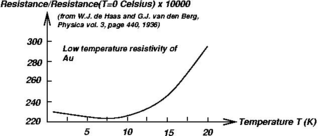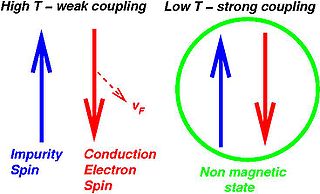
Kondo effect
Encyclopedia

The effect was first described by Jun Kondo
Jun Kondo
Jun Kondo is a theoretical physicist in Japan. His research is famous for the Kondo effect.- Honours and appointments :*1959 Dr...
, who applied third-order perturbation theory to the problem, which predicted that the scattering rate of conduction electrons off the magnetic impurity should diverge as the temperature approaches 0 K. The temperature dependence of the resistivity including the Kondo effect is written as:

where ρ0 is the residual resistance, aT2 shows the contribution from the Fermi liquid properties, and the term bT5 is from the lattice vibrations; a, b and cm are constants. Jun Kondo derived the third term of the logarithmic dependence.
Later calculations refined this result to produce a finite resistivity but retained the feature of a resistance minimum at a non-zero temperature. One defines the Kondo temperature as the energy scale limiting the validity of the Kondo results. The Anderson impurity model and accompanying renormalization
Renormalization
In quantum field theory, the statistical mechanics of fields, and the theory of self-similar geometric structures, renormalization is any of a collection of techniques used to treat infinities arising in calculated quantities....
theory was an important contribution to understanding the underlying physics of the problem.

Asymptotic freedom
In physics, asymptotic freedom is a property of some gauge theories that causes interactions between particles to become arbitrarily weak at energy scales that become arbitrarily large, or, equivalently, at length scales that become arbitrarily small .Asymptotic freedom is a feature of quantum...
, i.e. a situation where the coupling becomes non-perturbatively strong at low temperatures and low energies. In the Kondo problem, the coupling refers to the interaction between the localized magnetic impurities and the itinerant electrons.
Extended to a lattice of magnetic impurities, the Kondo effect likely explains the formation of heavy fermions
Heavy Fermion
In solid-state physics, heavy fermion materials are a specific type of intermetallic compound, containing elements with 4f or 5f electrons. Electrons, a kind of fermion, found in such materials are sometimes referred to as heavy electrons...
and Kondo insulators
Kondo insulator
In solid-state physics, Kondo insulators are understood as materials with strongly correlated electrons, that open up a narrow band gap at low temperatures with the chemical potential lying in the gap, whereas in heavy fermions the chemical potential is located in the...
in intermetallic compounds, especially those involving rare earth elements like cerium
Cerium
Cerium is a chemical element with the symbol Ce and atomic number 58. It is a soft, silvery, ductile metal which easily oxidizes in air. Cerium was named after the dwarf planet . Cerium is the most abundant of the rare earth elements, making up about 0.0046% of the Earth's crust by weight...
, praseodymium
Praseodymium
Praseodymium is a chemical element that has the symbol Pr and atomic number 59. Praseodymium is a soft, silvery, malleable and ductile metal in the lanthanide group. It is too reactive to be found in native form, and when artificially prepared, it slowly develops a green oxide coating.The element...
, and ytterbium
Ytterbium
Ytterbium is a chemical element with the symbol Yb and atomic number 70. A soft silvery metallic element, ytterbium is a rare earth element of the lanthanide series and is found in the minerals gadolinite, monazite, and xenotime. The element is sometimes associated with yttrium or other related...
, and actinide elements like uranium
Uranium
Uranium is a silvery-white metallic chemical element in the actinide series of the periodic table, with atomic number 92. It is assigned the chemical symbol U. A uranium atom has 92 protons and 92 electrons, of which 6 are valence electrons...
. In heavy fermion
Heavy Fermion
In solid-state physics, heavy fermion materials are a specific type of intermetallic compound, containing elements with 4f or 5f electrons. Electrons, a kind of fermion, found in such materials are sometimes referred to as heavy electrons...
materials, the nonperturbative growth of the interaction leads to quasi-electrons with masses up to thousands of times the free electron mass, i.e., the electrons are dramatically slowed by the interactions. In a number of instances they actually are superconductors. More recently, it is believed that a manifestation of the Kondo effect is necessary for understanding the unusual metallic delta-phase of plutonium
Plutonium
Plutonium is a transuranic radioactive chemical element with the chemical symbol Pu and atomic number 94. It is an actinide metal of silvery-gray appearance that tarnishes when exposed to air, forming a dull coating when oxidized. The element normally exhibits six allotropes and four oxidation...
.
More recently the Kondo effect has been observed in quantum dot systems. In such systems, a quantum dot with at least one unpaired electron behaves as a magnetic impurity, and when the dot is coupled to a metallic conduction band, the conduction electrons can scatter off the dot. This is completely analogous to the more traditional case of a magnetic impurity in a metal.
External links
- Jun Kondo's web page
- Kondo Effect - 40 Years after the Discovery - special issue of the Journal of the Physical Society of Japan
- The Kondo Problem to Heavy Fermions - Monograph on the Kondo effect by A.C. Hewson (ISBN 0-521-59947-4)
- Exotic Kondo Effects in Metals - Monograph on newer versions of the Kondo effect in non-magnetic contexts especially (ISBN 0-7484-0889-4)
- Correlated electrons in δ-plutonium within a dynamical mean-field picture, Nature 410, 793 (2001). Nature article exploring the links of the Kondo effect and plutonium

